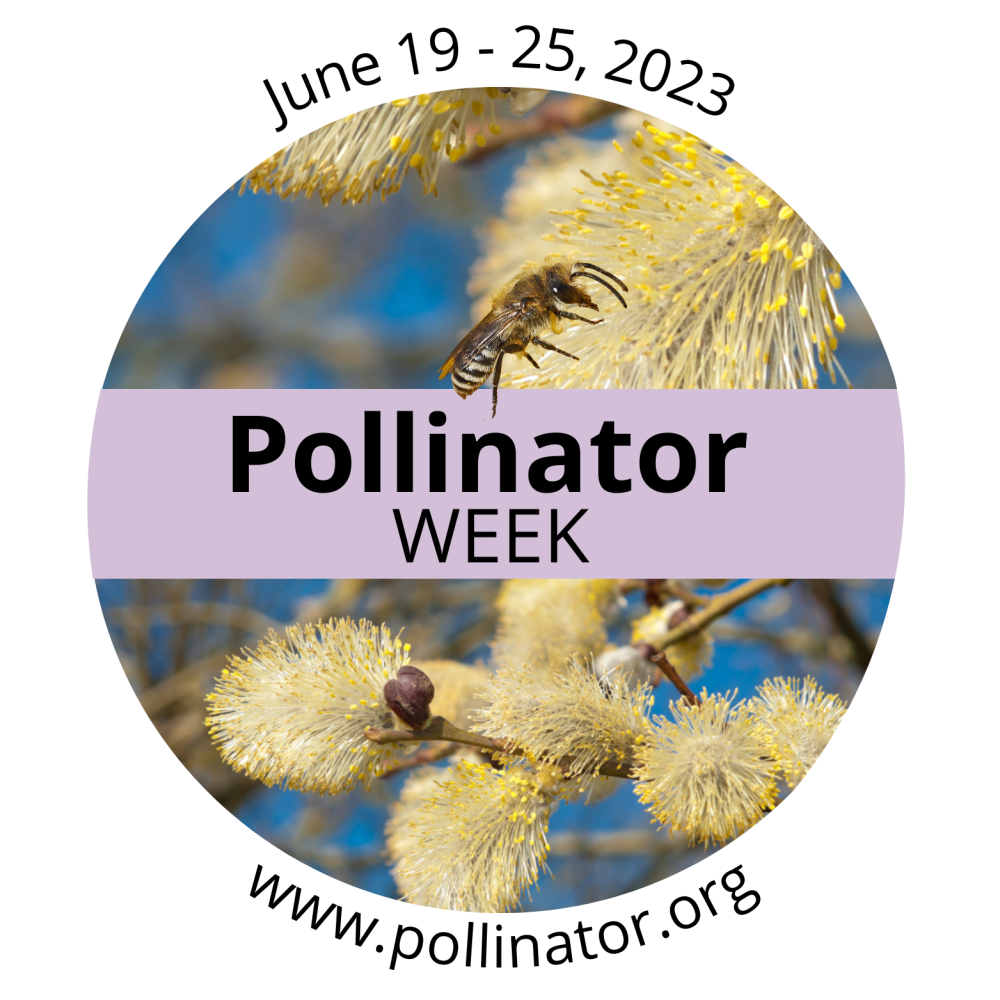Tips For Pollinator Week

Photo: pollinator.org
Got Pollinators?
Pollinator Week is June 19–25. Discover the joys of creating your own pollinator paradise! These hard-working heroes are essential for both food production and functioning ecosystems. Their numbers are declining dramatically, and they need our help to continue to provide their indispensable services. Here are some ways to be part of the solution:
- Learn how to protect pollinators and create pollinator habitat. (Scroll down to see list of do’s and don’ts.)
- Be generous! You’ll be blessed with an abundance of pollinator powerhouse plants as they proliferate on your property over time. Share seeds and starts of these native trees, shrubs, and herbaceous perennials with family members, friends, neighbors, and others – they make great gifts.
- Like and follow Pollinate Amherst, Hitchcock Center for the Environment, Massachusetts Pollinator Network, and Native Plants of New England on Facebook.
- Visit Massachusetts Pollinator Network online to access helpful resources about establishing pollinator habitat and ways to advocate for pollinators at the state level.
- Sign up to be a Pollinate Amherst volunteer helping to establish and manage our public plantings and/or participate in our pollinator awareness campaign. (Contact me at 413.961.9059 or info@johnroot.net.)
- Share this message widely via email, social media (repost from Pollinate Amherst on Facebook), and by word of mouth.
Protecting And Attracting Pollinators
- Reduce your lawn by 25% or more and replace with native plantings. Establish a diversity of woody and herbaceous plants that will provide pollen and nectar from April through October. Include host plants for caterpillars (some of which will feed hungry songbird chicks) as well. In addition to helping essential wildlife, you’ll also enjoy connecting to nature, inspire and educate others, and significantly enhance the value of your property.
- Sheet mulch to transition from grass or other unwanted vegetation to pollinator habitat. This no-dig technique uses overlapping pieces of cardboard or builders paper covered with mulch (shredded bark mulch, wood chips, pine needles, and leaves) to eliminate existing vegetation.
- Consider testing your soil. The addition of amendments may be advisable, especially if existing vegetation appears unhealthy.
- Provide nesting and overwintering habitat. Leave patches of bare earth for ground nesting bees or make a “sandbox” containing equal parts sand and soil. Cut stalks of pithy and hollow stems at a height of 6” – 18” at the end of the growing season and leave them as long as possible to provide brood chambers for cavity nesting bees in succeeding years. Leave the leaves (especially under tree canopies) instead of raking and disposing of them to provide a refuge for overwintering caterpillars. Leave snags (dead tree trunks) and fallen logs and create a brush pile for wildlife habitat.
- Mow every other week at a height of at least 3” to allow clover, self heal, violets, wild strawberries, thyme, and other flowering plants to bloom. Refrain from using herbicides and consider introducing these and other low-growing flowering plants into your lawn.
- Eliminate or control invasive plants on your property. Becoming familiar with these species and being vigilant in controlling them is essential for maintaining the health of pollinator plantings.
- Avoid cultivars and “nativars” (cultivars of native species). These varieties have ornamental appeal, but are often less valuable to pollinators and foraging caterpillars. They can also contaminate the gene pool of native species and are less hardy than wild plants.
- Just say “NO” to Mosquito Joe! Spraying for mosquitoes is ineffective. Also, these broad-spectrum pesticides are lethal to all insects and other wildlife, and possibly to pets and humans as well. Instead, eliminate standing water on your premises and kill mosquito larvae with Bt bacteria in baited buckets.
Native Plant Nurseries and Seed Sources
- Wing and a Prayer Nursery in Cummington (open Sunday and Monday from 9:00 AM to 3:00 PM) provides a wonderful selection of seed-grown native plants as well as expert advice regarding what to plant on your property.
- Nasami Farm in Whately (open Saturdays and Sundays from 10:00 AM to 5:00 PM) has a large collection of both woody and herbaceous plants. Be sure to ask for native plants rather than cultivars.
- That’s a Plenty Farm in Hadley (open by appointment) offers many native plants as well as seeds.
Other nurseries in the Pioneer Valley with good collections of native pollinator plants include Tripple Brook Farm (Southampton), Checkerspot Farm (Colrain), and Turtle Bend Farm (Montgomery).
Native seeds can be purchased from Wild Seed Project, Ernst Seeds, and Prairie Moon Nursery.

Thanks, John for these very helpful tips! While our property doesn’t have enough sun to plant a full-sun pollinator garden, we finally tackled removal of several large burning bush and other invasives this year and replaced them with lots of shade-loving native plants. This is such a learning experience and happily we’re already seeing new bird species attracted to our property. The use of Mosquito Joe continues to be an issue everywhere, but hopefully, articles such as this will help convince everyone that mosquito spraying is a very bad idea for both the environment and human health. Also, I’m happy to learn about the work of Pollinate Amherst and will check it out.